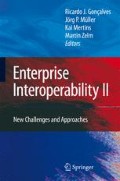Abstract
Interoperability is a prerequisite for enterprise collaborations. However continuing evolution of enterprise and enterprise networks as well the proliferation of different mature and overlapping standards create heterogenic and unstable situations for all stakeholders. There exists not the solution for overcoming the current situation. Collaborating enterprises and networks require a consolidated and consistent understanding across the stakeholders. This has to be gathered from the sometimes unstructured and incomplete knowledge regarding the processes within and between organisations. In the paper an approach is described how to achieve interoperability in an incremental way. It is based on four main interrelated aspects, first a five level interoperability architecture which separates the connectivity between organisations and systems from business to execution data, second the Business Scope of interoperability tasks to be performed, third interoperability maturity levels and fourth an establishment framework and their reflection existing interoperability solutions. Based on given approaches for synchronising distributed enterprise models the framework is applied for supporting the development of an ASP solution for supply chain management. The approach combines aspects from the work elaborated in three EU IST projects: ATHENA-IP, INTEROP-NoE and SPIDER-WIN[1, 2, 3].
Access this chapter
Tax calculation will be finalised at checkout
Purchases are for personal use only
Preview
Unable to display preview. Download preview PDF.
6 References
INTEROP, Interoperability Research for Networked Enterprises Applications and Software NoE, (2005) (IST-2003-508011) http://www.interop-noe.org
SPIDER-WIN, Supply Information Dynamic Exchange and Control by Web-based Interaction Network Project 2004–2006) (IST-2004-507 601) http://www.spiderwin.de
Knothe, T., Schneider, K., Böll, D., Kahl, T., Schuster, S., Lillehagen, F., Krogstie, J., Grenager Solheim, H. (2005) First Version of Establishing and management approach, Deliverable A1.4.1, ATHENA, Integrated Project-Contract no:IST-507849
Knothe, T.; Jochem, R.: Enterprise Modelling Approach based on Maturity and Business Scope perspectives, paper accepted for COMA07 conference, Stellenbosch, S.A: 2007
Knothe, Thomas; Kahl, Timo; Böll, Dieter; Schneider, Kristof: “Framework for Establishing Enterprise Modeling in the Context of Collaborative Enterprises”, paper accepted for the HICSS 2007.
INTEROP TG 1: http://153.97.93.166/sddem/reference-approaches
Opdahl, A.L.: Multi-Perspective Multi-Purpose Knowledge Modelling. In Concurrent Engineering: Enhanced Interoperable Systems-The Vision for the Future Generation in Research and Applications, pp. 609–617
Opdahl A.L., Henderson-Sellers B. (2004). A Template for Defining Enterprise Modelling Constructs. Journal of Database Management (JDM) 15(1). Idea Group Publishing, 2004. To appear.
Lillehagen, Frank: Lillehagen F.: Process Design, 1995, Presentation at MNEMOS Methodology Workshop, Aerospatiale, Toulouse, AT&T Gis.
Jäkel, F.-W.; Arroyo Pinedo, J.S. (2000): Development of a Demonstrator for Modelling and Simulation of Global Distributed Enterprises. In: Mertins, K.; Rabe, M. (Eds.): The New Simulation in Production and Logistics. 9th ASIM Dedicated Conference on Simulation in Production and Logistics, Berlin, pp. 375–384.
Chalmeta R., Grangel R., Ortiz A., Poler R. (2003): Virtual Integration of the Tile Industry (VITI) Conceptual Modeling for Novel ApplicationDomains. Vol. 2814. Lecture Notes in Computer Science. October
Rabe, M., B. Mussini, P. Gocev and H. Weinaug (2005b). Requirements and potentials of new supply chain business processes in SME networks. In: Cunningham, P.; Cunningham, M. (Editor) Innovation and the Knowledge Economy — Issues, Applications, Case Studies. Paper eChallenges 2005, Ljubljana. S. 1645–1652
Author information
Authors and Affiliations
Editor information
Editors and Affiliations
Rights and permissions
Copyright information
© 2007 Springer-Verlag London Limited
About this paper
Cite this paper
Mertins, K., Knothe, T., Jäkel, F.W. (2007). Enterprise Interoperability enabling Enterprise Collaboration. In: Gonçalves, R.J., Müller, J.P., Mertins, K., Zelm, M. (eds) Enterprise Interoperability II. Springer, London. https://doi.org/10.1007/978-1-84628-858-6_34
Download citation
DOI: https://doi.org/10.1007/978-1-84628-858-6_34
Publisher Name: Springer, London
Print ISBN: 978-1-84628-857-9
Online ISBN: 978-1-84628-858-6
eBook Packages: EngineeringEngineering (R0)

